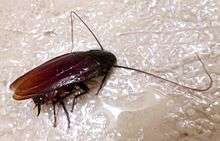Japanese cockroach
The Japanese cockroach (Periplaneta japonica), also known as the Yamato cockroach,[1] is a cockroach native to Japan, adapted to cooler northern climates.[2][3][4] It has a flexible univoltine or semivoltine (one- or two-year) lifecycle, depending on the timing of its hatching, and is unusual in being able to spend two winters as diapause nymphs before reaching maturity.[3]
| Periplaneta japonica | |
|---|---|
 | |
| Scientific classification | |
| Kingdom: | |
| Phylum: | |
| Class: | |
| Order: | |
| Family: | |
| Genus: | |
| Species: | P. japonica |
| Binomial name | |
| Periplaneta japonica Karny, 1908 | |
Freeze tolerance
Nymphs have been observed in the wild hibernating in subfreezing temperatures during winter in snow-covered habitats.[5] Overwintering nymphs were able to survive laboratory supercooling experiments in the -5 to -8 °C temperature range, enduring 12 hours of tissue freezing,[6] as well as recover from burial in ice.[1] The ability to walk on ice was also found to be unique among several cockroach species tested.[1]
Physiology
Initial first-instar nymphs are dark brown, with white or brownish white tips of the maxillary and labial palps. Adults measure 25–35 mm in length, and have a shiny, uniformly black to blackish-brown body, with brown tarsi and maxillary and labial palps. The adult male's wings extend slightly beyond the body's length, while the female's wings are around half the body's length.[7]
Unlike most cockroaches, the major hydrocarbon in P. japonica’s cuticular lipids is cis-9-nonacosene.[8] Males have significant amounts of cis-9-heptacosene not found on females.[8] Glucose, myo-inositol, scyllo-inositol and trehalose were found in overwintering nymphs and are thought to be a factor in their freeze tolerance.[6]
Habitat
Primarily an outdoors species, populations are adaptable to living indoors in houses and buildings where food is stored, prepared, or served.[7][9]
Defense
A P. japonica nymph alone or in sparse populations accumulates a viscous secretion along its rear dorsal surface, droplets of which it can be splashed some distance toward a threat through a shaking action. The presence of an aggressive species of ant, Formica exsecta, triggered this defensive response, rendering the ants helpless.[10]
Presence as an introduced species
Originally from Japan, P. japonica has spread to China, Korea and southeast Russia, though it is considered a common pest primarily in central and northern Japan.[4][7][9][11]
The species was found in New York City in 2013, the first time the species was found in the United States.[12] It was found by an exterminator beneath plantings in High Line, a Manhattan park, and was able to survive over a cold winter.[13] Scientists who confirmed the identity of the species through genetic testing theorize that it may have been imported in the soil of ornamental plants used in the park.[12]
References
- Tanaka, S (May 2002). "Temperature acclimation in overwintering nymphs of a cockroach, Periplaneta japonica: walking on ice". Journal of Insect Physiology. 48 (5): 571–583. doi:10.1016/s0022-1910(02)00077-x.
- Encyclopedia of Life. "Japanese Cockroach - Periplaneta japonica". Retrieved 9 December 2013.
- Tanaka, Seiji; Uemura, Yoshinobu (August 1996). "Flexible Life Cycle of a Cockroach Periplaneta japonica with Nymphal Diapause". Journal of Orthoptera Research. Orthopterists’ Society (5): 213–219. JSTOR 3503596.
- Forman, Rob (9 December 2013). "Cockroach Never Seen Before in U.S. Is Identified in New York". Rutgers Today. Retrieved 9 December 2013.
- Yuichiro, Tabaru; Atsushi, Kobayashi (1971). "Outdoor hibernation of Periplaneta japonica (Blattaria: Blattidae) in snowy area" (PDF). Japanese Journal of Sanitary Zoology (in Japanese and English). 22 (2): 76–77. Retrieved 9 December 2013.
- Tanaka, Kazuhiro; Tanaka, Seiji (October 1997). "Winter Survival and Freeze Tolerance in a Northern Cockroach, Periplaneta japonica (Blattidae : Dictyoptera)". Zoological Science. The Zoological Society of Japan. 14 (5): 849–853. doi:10.2108/zsj.14.849. ISSN 0289-0003. Retrieved 9 December 2013.
- Robinson, William H. (14 April 2005). Urban Insects and Arachnids: A Handbook of Urban Entomology. Cambridge University Press. p. 56. ISBN 978-0-521-81253-5. Retrieved 9 December 2013.
- Morris Rockstein (2 December 2012). The Physiology of Insecta. Elsevier Science. p. 236. ISBN 978-0-323-16157-2. Retrieved 9 December 2013.
- Resh, Vincent H.; Cardé, Ring T. (22 July 2009). Encyclopedia of Insects. Academic Press. p. 110. ISBN 978-0-08-092090-0. Retrieved 9 December 2013.
- Ichinose, T; Zennyoji, K (1980). "Defensive behavior of the cockroaches, Periplaneta fuliginosa Serville and P. japonica Karny (Orthoptera: Blattidae) in relation to their viscous secretion". Applied Entomology and Zoology. 15 (4): 400–408. ISSN 0003-6862. Retrieved 9 December 2013.
- "Catalogue of Life – 19th November 2013: Species details". Catalogue of Life. Retrieved 9 December 2013.
- "Cockroach that can endure cold moves into NYC". USA Today. 9 December 2013. Retrieved 9 December 2013.
- Frishman, Austin M.; Bello, Paul J. The Cockroach Combat Manual II. Author House. p. 8. ISBN 978-1-4918-2064-3. Retrieved 9 December 2013.
